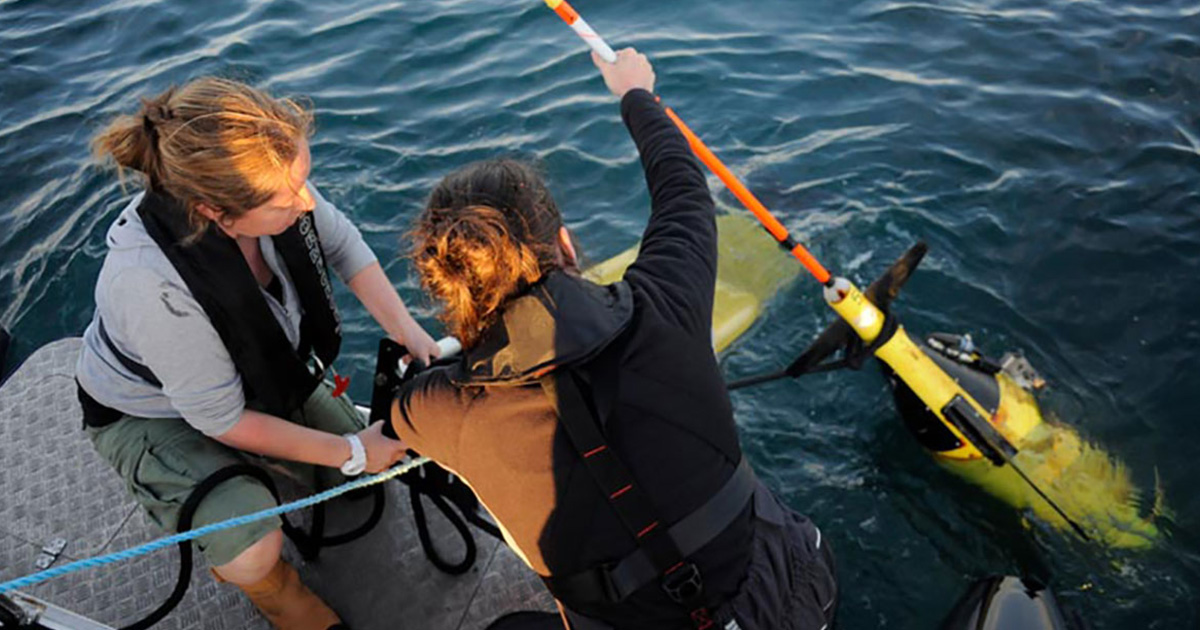SAMS (Scottish Association for Marine Science) scientists are using data from underwater robots to investigate what they describe as an ‘extraordinary’ marine heatwave event in the Atlantic Ocean, west of Scotland.
Satellites revealed record sea surface temperatures in the region in mid-June, but data from an autonomous underwater vehicle, known as a glider, operated by SAMS has given further insight into the warming event.
The glider operates in the open ocean for months at a time, collecting oceanographic measurements down to 1,000 meters and resurfacing every few hours to report back its findings. It revealed that the extreme sea temperatures were in the first 20 meters of the ocean, with relatively typical temperatures below that.
SAMS oceanographers believe this top layer of extremely warm water could have profound effects on ocean systems that dictate our climate.
“It’s like nothing we’ve seen before,” said SAMS oceanographer Dr. Neil Fraser. “The peak sea surface temperature is the hottest on record and up to 5˚C warmer than the average for June. To put it into context, the seasonal sea surface temperature peak is not usually until August.”
SAMS has operated gliders in the north-east Atlantic since 2010 but has had near continuous glider data collection for the past 10 years. Over that time, the gliders have been on 29 missions, travelling a combined 65,000 kilometers.
This continuity is giving scientists new insights into warming events and the glider’s ability to make regular measurements through the water column is filling in crucial data gaps.
“Satellites are great at measuring the sea surface ‘skin’ over a large area and the shallowest fixed mooring sensors we have are about 50 meters’ depth, so gliders are really coming into their own," said Dr. Fraser. "It’s like having a mobile thermometer in the ocean.
“Another advantage is the gliders can inform us of such heatwave events as they are happening. Over time, they might also be able to tell us where this heat goes. Will it mix into the ocean, or will it be absorbed into the atmosphere?”
Scientists hypothesize that the cause of the recent marine heatwave could be a shifting and weakening of the trade winds, which would normally cool the sea surface. By examining glider data in more detail, they aim to investigate the causes of the marine heatwave and the implications for the deeper ocean.
SAMS gliders continually monitor the north-east Atlantic, where the exchange between the salty and relatively warm Atlantic water and the colder, fresher Arctic Ocean plays a major role in global climate.
A large system of ocean currents, known as the Atlantic Meridional Overturning Circulation (AMOC) transports warm surface waters from the tropics northward towards the subpolar and Arctic regions. There, the waters cool, become denser and sink before returning southward at depth. In doing so, this vast ‘conveyor belt’ movement of water is a major factor in controlling global heat distribution, regional sea level changes, the ocean’s absorption of carbon and European weather.
SAMS oceanographer Prof Stuart Cunningham, said: “While the AMOC is not likely to have been the driver of this recent heatwave, we are very interested to find out whether these extraordinary sea surface temperatures will have an effect on the system.
“Often described as Europe’s central heating system, the AMOC relies on the water being much cooler in the global north. If the water is too warm, this can inhibit the dense water formation which drives the AMOC, and that could have profound effects on global climate and weather.”



